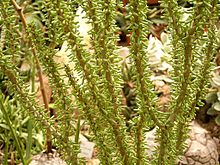
Namaqualand is an arid region of Namibia and South Africa, extending along the west coast over 1,000 km (600 mi) and covering a total area of 440,000 km2 (170,000 sq mi). It is divided by the lower course of the Orange River into two portions – Little Namaqualand to the south and Great Namaqualand to the north.
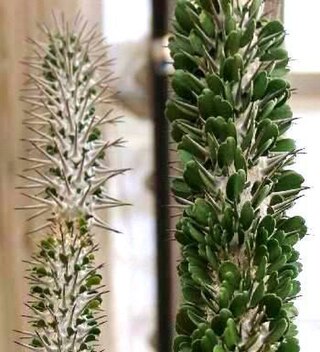
Didiereaceae is a family of flowering plants found in continental Africa and Madagascar. It contains 20 species classified in three subfamilies and six genera. Species of the family are succulent plants, growing in sub-arid to arid habitats. Several are known as ornamental plants in specialist succulent collections. The subfamily Didiereoideae is endemic to the southwest of Madagascar, where the species are characteristic elements of the spiny thickets.

The Namaqua chameleon is a ground-living lizard found in the western desert regions of Namibia, South Africa and southern Angola.
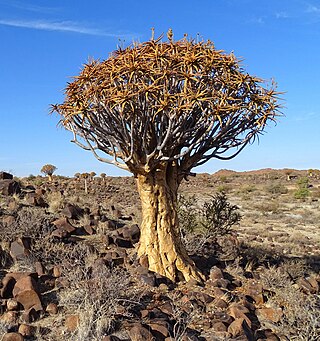
Aloidendron dichotomum, formerly Aloe dichotoma, the quiver tree or kokerboom, is a tall, branching species of succulent plant, indigenous to Southern Africa, specifically in the Northern Cape province of South Africa, and parts of Southern Namibia.

Portulacaria is a genus of succulent plant, classified in its own subfamily Portulacarioideae in the family Didiereaceae. It is indigenous to southern Africa.
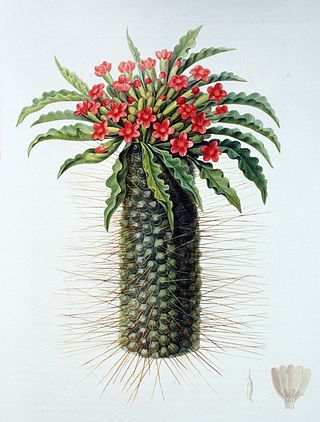
Pachypodium namaquanum, also known as halfmens or elephants trunk, is a succulent plant of Southern Africa. The genus name Pachypodium is from the Greek for 'thick foot', an allusion to its swollen base, while the species name namaquanum is a reference to Namaqualand.

The Namaqua rain frog or Namaqua short-headed frog is a species of frogs in the family Brevicipitidae. It is found in Namaqualand in western South Africa and extreme southern Namibia.

Gonialoe dinteri, the Namibian partridge aloe, is a species of flowering plant in the Asphodelaceae family. It is native to arid areas of Angola and Namibia.

Aloidendron pillansii, formerly Aloe pillansii, the giant quiver tree or bastard quiver tree, is a large, branching species of succulent plant indigenous to southern Africa. It is regarded as critically endangered.

In botany, succulent plants, also known as succulents, are plants with parts that are thickened, fleshy, and engorged, usually to retain water in arid climates or soil conditions. The word succulent comes from the Latin word sucus, meaning "juice" or "sap".

Namaqua National Park is a South African national park situated approximately 495 km north of Cape Town and 22 km northwest of Kamieskroon. It has an area of more than 1300 km2. The park is part of Namaqualand, an area covering 55,000 km2 located within the semi-desert Succulent Karoo biome. This biome is a biodiversity hotspot with the largest concentration of succulent plants in the world. The park also has an arid environment with succulent plants. The park was created to protect its flowers. During the spring, wildflowers bloom there in a spectacular fashion. The park's main tourist attraction is this abundant spring bloom of brightly coloured wildflowers.

Portulacaria afra is a small-leaved succulent plant found in South Africa. These succulents commonly have a reddish stem and leaves that are green, but also a variegated cultivar is often seen in cultivation. They are simple to care for and make easy houseplants for a sunny location. In frost-free regions they may be used in outdoor landscaping.
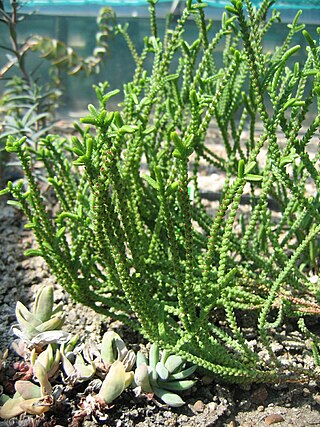
Crassula muscosa, synonyms Crassula lycopodioides and Crassula pseudolycopodioides, is a succulent plant native to South Africa and Namibia, belonging to the family of Crassulaceae and to the genus Crassula. It is a houseplant grown worldwide and commonly known as rattail crassula, watch chain, lizard's tail, zipper plant and princess pines.
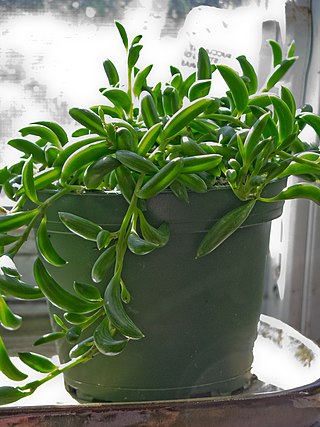
Curio radicans, syn. Senecio radicans, is a succulent houseplant that is native to Southern Africa. A member of the family Asteraceae, the asters, this species is closely related to the common string of pearls and Curio hallianus. It has multiple tendrils of glossy, banana-shaped foliage. It is commonly known as string of bananas or fishhook senecio.

Gasteria pillansii, the Namaqua gasteria, is succulent plant native to the arid winter-rainfall regions in the far west of South Africa and Namibia.

Portulacaria pygmaea, also known as the pygmy porkbush, is a small-leaved dwarf succulent plant found on the border between Namibia and the Cape Provinces of South Africa.
Portulacaria armiana, also known as the whipstick-porkbush, is a succulent plant native to southwestern Namibia.
Portulacaria carrissoana is a shrubby succulent plant found on the border between Namibia and Angola.

Portulacaria fruticulosa is a succulent plant found in southwestern Namibia and the northwestern Cape Provinces of South Africa.
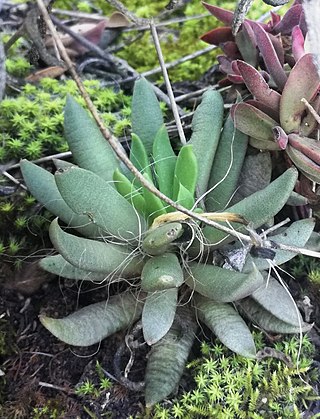
Anacampseros lanceolata is a species of succulent plant native to the western Karoo and Overberg regions of South Africa.

